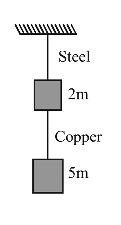Mechanical Properties of Solids
- Two wires A and B are of the same material. Their lengths are in the ratio 1 : 2 and the diameter are in the ratio 2 : 1. If they are pulled by the same force, then increase in length will be in the ratio
-
View Hint View Answer Discuss in Forum
We know that Young's modulus
Y = F × L πr² l
Since Y, F are same for both the wires, we have,1 L1 = 1 L2 r1² l1 r2² l2 or, l1 = r2² × L1 = (D2/2) × L1 mv² l2 r1² × L2 (D1/2) × L2 or, l1 = D2² × L1 = D2 L1 × L2 = 1 l2 D1² × L2 (2D2)² 2L2 8
So, l1: l2 = 1 : 8Correct Option: C
We know that Young's modulus
Y = F × L πr² l
Since Y, F are same for both the wires, we have,1 L1 = 1 L2 r1² l1 r2² l2 or, l1 = r2² × L1 = (D2/2) × L1 mv² l2 r1² × L2 (D1/2) × L2 or, l1 = D2² × L1 = D2 L1 × L2 = 1 l2 D1² × L2 (2D2)² 2L2 8
So, l1: l2 = 1 : 8
- If the ratio of diameters, lengths and Young’s modulus of steel and copper wires shown in the figure are p, q and s respectively, then the corresponding ratio of increase in their lengths would be

-
View Hint View Answer Discuss in Forum
From formula,
Increase in length = ΔL = FL = 4FL AY πD²Y ΔLs = Fs 
Dc 
² Yc Ls = 7 × 
1 
² 
1 
q ΔLc Fc Ds Yc Lc 5 p s = 7q (5sp²) Correct Option: C
From formula,
Increase in length = ΔL = FL = 4FL AY πD²Y ΔLs = Fs 
Dc 
² Yc Ls = 7 × 
1 
² 
1 
q ΔLc Fc Ds Yc Lc 5 p s = 7q (5sp²)
- The following four wires are made of the same material. Which of these will have the largest extension when the same tension is applied ?
-
View Hint View Answer Discuss in Forum
F = YA/L × l So, extension, l ∝ L/A ∝ L/D² [∵ F and Y are constant]
l1 ∝ 100/l² ∝ 100 and l2α (200/2²)∝ 50
l3∝ 300/3² ∝ 100/3 and l4 ∝ (50/(1/4)) ∝ 200
The ratio of L/D² is maximum for case (d).
Hence, option (d) is correct.Correct Option: D
F = YA/L × l So, extension, l ∝ L/A ∝ L/D² [∵ F and Y are constant]
l1 ∝ 100/l² ∝ 100 and l2α (200/2²)∝ 50
l3∝ 300/3² ∝ 100/3 and l4 ∝ (50/(1/4)) ∝ 200
The ratio of L/D² is maximum for case (d).
Hence, option (d) is correct.
- Copper of fixed volume ‘V; is drawn into wire of length ‘l’. When this wire is subjected to a constant force ‘F’, the extension produced in the wi re is ‘∆l’. Which of the following graphs is a straight line?
-
View Hint View Answer Discuss in Forum
As Y = F ⇒ Δ l = A Fl Al AY l But V = Al so A = V l Therefore ∆l = Fl² ∝ l² VY
Hence graph of ∆l versus l2 will give a straight line.Correct Option: B
As Y = F ⇒ Δ l = A Fl Al AY l But V = Al so A = V l Therefore ∆l = Fl² ∝ l² VY
Hence graph of ∆l versus l2 will give a straight line.
- The Young's modulus of steel is twice that of brass. Two wires of same length and of same area of cross section, one of steel and another of brass are suspended from the same roof. If we want the lower ends of the wires to be at the same level, then the weights added to the steel and brass wires must be in the ratio of :
-
View Hint View Answer Discuss in Forum
Young's modulus Y = W . l A Δl W1 = W2 Y1 Y2
[ ∵ A, l, ∆l same for both brass and steel]
W1 = W2 = 2 W1 Y2
[Ysteel/Ybrass = 2 given]Correct Option: A
Young's modulus Y = W . l A Δl W1 = W2 Y1 Y2
[ ∵ A, l, ∆l same for both brass and steel]
W1 = W2 = 2 W1 Y2
[Ysteel/Ybrass = 2 given]

